Premium
Crews take stock of performance as the dust settles on Safari Rally
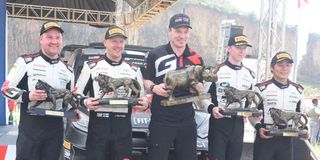
Toyota Gazoo Team Principal Jari-Matti Latvala (centre), WRC Safari Rally 2024 winner Kalle Rovanpera (second right), second-placed Takamoto Katsuta (right) and their navigators Jonne Halttunen and Aaron Johnstone at Hell's Gate in Naivasha on March 31, 2024.
What you need to know:
- Toyota’s Kalle Rovanpera and his co-driver Jonne Halttunen won the Safari Rally on Sunday
- Toyota lead Hyundai by four points in the manufacturers’ championship
- Carl Tundo and his navigator Tim Jessop, driving a Ford Fiesta car, were the highest placed Kenyans in 16th place
Kalle Rovanpera of Finland returns home a hero as the FIA observer prepares his post mortem report on the World Rally Championship Safari Rally.
Manufacturers, drivers and fans are also taking stock of the competition, which took place from March 28-31 in Nairobi and Naivasha. Toyota’s Kalle Rovanpera and his co-driver Jonne Halttunen won the Safari Rally on Sunday, with Hyundai’s Thierry Neuville stretching his championship lead to six points despite finishing only fifth.
Double world champion Rovanpera, competing in selected events only this season before a full return next year, led from Friday and finished one minute and 37.8 seconds clear of his team mate Takamoto Katsuta over the rough gravel roads.
M-Sport Ford’s Adrien Fourmaux finished third. Toyota lead Hyundai by four points in the manufacturers’ championship, and the next round is in Croatia, on asphalt, from April 18-21.
Although this year’s competition lacked the buzz of the last two editions, for Rovanpera, his co-driver Jonne Halttunen, and the Toyota team, the harvest in Kenya was bountiful.
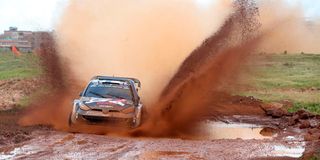
Kalle Rovanpera and his navigator Jonne Halttunen in a Toyota Yaris compete in the Kasarani Super special stage of the 2024 WRC Safari Rally on March 28, 2024.
Rovanpera won his second WRC Safari Rally title in a Toyota Yaris GR Hybrid two years his first after four days of relentless competition in Nairobi, Naivasha and Gilgil.
This was yet another successful round of the FIA World Championship, which this year had the distinction of promoting the beautiful images of Kenya as a tourism destination in 50 countries through 150 stations, reaching 82 million people.
The Safari Rally was brought forward to Easter holidays from June to recreate a historic past when nothing else mattered in East Africa around that time. It was meant to attract more fans, and to avoid disrupting normal life, given that previous editions held since 2021 have witnessed traffic snarl up on all roads leading to, and from Naivasha.
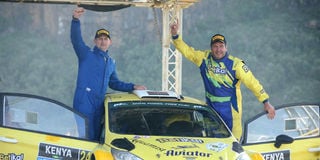
Carl Tundo (right) and his navigator Tim Jessop celebrate after winning KNRC category of WRC Safari Rally at Naivasha on March 31, 2024.
Carl Tundo and his navigator Tim Jessop, driving a Ford Fiesta car, were the highest placed Kenyans in 16th place in the main World Rally Championship (WRC), but they were seventh in the Rally 2 category, and came out top of the Kenya National Rally Championship (KNRC) category.
Reigning Africa Rally Championship winner, Karan Patel, was 18th overall, having retired on Saturday but re-joined the rally on Sunday after mechanics fixed the strut in his Skoda Fabia car.
“I am happy with my performance in the Safari Rally, and I feel encouraged to compete once again in the Africa Rally Championship series,” Patel said.
He was followed by Aakif Virani (Skoda Fabia) and Minesh Rathod (Mitsubishi Lancer EVO) in the main WRC category.
A senior Executive of the WRC Promoter, the German-based commercial rights holder of the FIA WRC, Peter Thul, estimated that the Safari Rally will have realised or exceeded its media commercial value, which is estimated at over Sh4 billion, following concerted effort with the Kenyan government to create pre-event media publicity. Top drivers visited the Masai Mara and shared their experiences with millions of fans around the world on social media.
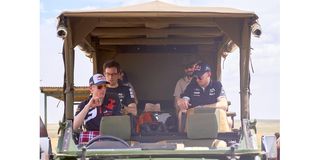
Rally drivers Elfyn Evans ( in a cap on the left), Thierry Neuville ( behind Evans), Gregoire Munster (right), Nicholas Ciamini (behind on the left) and his navigator Yannick Roche inside a 4X4 open-side safari jeep at Masai Mara on March 24, 2024. The drivers are in Kenya for the 2024 World Rally Championship Safari Rally from March 28 to 31 in Naivasha.
In addition, Thul said the WRC and FIA are very much willing to remain in Kenya as the Safari Rally is a unique event in the 13-rounds WRC calendar, and the only one in Africa as they have financial guarantees from the government, and aspirations for growth in the corporate sector which came through commercial sponsorship for the event and drivers.
The KCB Bank, Toyota Kenya, Safaricom and Betika were some of the sponsors who supported the event and drivers, led by Carl Tundo who finished 16th overall in the main World Rally Championship category, and seventh in the Rally 2 category.
Rovanpera, twice youngest world champion ever at age 24, drove through the 367km competitive distance after taking the lead on Friday from Belgian Thierry Neuville, driving a Hyundai i20 Hybrid Rally1 car. Neuville had won the Kasarani Super Special Stage on Thursday by winning all the six stages of the day.
He started the day with a lead of over 2 minutes 55 seconds over team mate Takamoto Katsuta and still managed to ease off to safeguard his lead despite team Katsuta closing in but could only manage to reduce this gap to 1:37.8 minutes.
“Lottery stage,” said Katsuta after a puncture at Malewa morning stage which affected his challenge to Rovanpera “Quite stupid to be honest."
Frenchman Adrien Fourmaux completed the podium and gave M-Sport Ford a morale boosting third position and their first podium finish in 22 years since the late Colin McRae won the 2002 Safari Rally in a Ford Focus.
The young Frenchman, 29, has also been sponsored by Mpesa Global and Kenya Airways. He will be flying colours of both companies in the WRC remaining 10 rounds.
Toyota's Elfyn Evans finished fourth followed by Neuville. Thierry Neuville, who had started the Safari on a promising note but mechanical issues dogged him throughout the rally. He was unable to pick maximum points on Sunday following an impact with a rock, which broke the right-rear suspension on his Hyundai i20 N Rally1 at Hells Gate.
“Impossible to avoid,” Neuville lamented. “I don’t know where they come from but they were massive, two of them.”
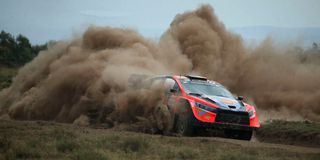
Thierry Neuville navigated by Matijn Wydaeghe in a Hyundai i20 compete in the Kedong stage of the 2024 WRC Safari Rally on March 29, 2024.
Title rival Evans is set to benefit from Neuville’s trouble. But he had sympathy for Neuville’s situation: “It’s a shame. Sometimes it’s a bit of a lottery like that.”
The Safari was divided into three categories--World Rally Championship for Priority 1 drivers; World Rally Championship for Priority 2 drivers; Kenya National Rally Championship for local drivers who do not have modern machines. They competed in only one loop daily of the two loops rally in Kedong/Geothermal/Loldia stages on Friday.
Leg Two was at Soysambu/Elementaita and Sleeping Warrior in Gilgil and Leg three on Sunday at Malewa/Oserian/Hells Gate.





